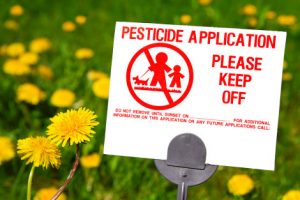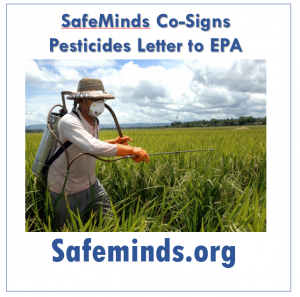A letter drafted by the National Resources Defense Council (NRDC) was submitted today to EPA Office of Pesticide Programs (OPP). The letter addresses the Request for Comment on the draft Pesticide Cumulative Risk Assessment: Framework for Screening Analysis. The autism advocacy group SafeMinds joined 28 environmental organizations in requesting changes to how EPA determines cumulative risk to pesticides.
This effort has several potential areas of impact for resolving the autism epidemic.
First, NRDC offers an alternative to outdated toxicity assessment based on current science. NRDC’s new recommendation considers “multiple
pathways” as factors in cumulative risk, rather than OPP’s current single pathway assessment. This multiple pathways toxicity assessment approach could be applied to any chemical exposure that may be playing a role in autism risk, such as mercury, flame retardants or another pesticide like glypohosate which can alter immune function, detoxification, and microbiome composition. Under the recommendations, all three pathways would be included in an assessment.
NRDC also recommends OPP consider “multiple agents” or “stressors” that can lead to the same health outcome, rather than focusing on just the single chemical agent under assessment. An example might be an individual with autism who has a nutritional deficiency (for instance, low folate) that makes that individual more susceptible to mercury retention. The NRDC recommendation would include that nutritional status – or any other susceptibility condition – in a risk analysis.
Second, pesticides have been implicated in autism risk, so EPA’s efforts in accurately predicting toxicity to pesticides specifically may help avert  exposures that contribute to autism onset, co-morbidities or severity.
exposures that contribute to autism onset, co-morbidities or severity.
A third relevant recommendation is for EPA to conduct a comprehensive systematic literature review that includes not just epidemiology, but in vivo, in vitro and computational (“in silica”) studies. The review would need to evaluate study bias. In autism, we have seen substances ruled out as etiological factors based on biased epidemiology alone, without giving weight to animal and cell culture studies.
The NRDC letter contains many more beneficial recommendations that would advance the field of exposure assessment. While technical, the entire letter is worth a review. The careful reader will learn a great deal. The autism epidemic will be resolved only when harmful environmental exposures increasing risk for autism or its associated conditions are identified and eliminated.


 HOW SAFEMINDS IS HELPING
HOW SAFEMINDS IS HELPING
